
from eastern lands

 |
Odds and
ends from eastern lands |
 |
| Ukraine, 8. – 21.7. 2007 | ||
| ***** |
||
|
Sunday 8 /
Day One
Sweet Tooth Arrival at Boryspil airport. An endless human swarming, and somewhere on the horizon the counters with passport control. So waiting... and waiting... and waiting. It takes almost an hour before I make it to the counter and am presented with a green rubber stamp in my passport. (In the past, the rubber stamps were always red. Have they recognized my sympathies for the Greens?) I go to pick up my luggage. No mention of the flight from Prague on the main monitor, so I make a slow round around all the moving belts. No mention of the flight from Prague anywhere. Hmm. It has been an hour since the landing. They must have unloaded the luggage by now. So where is it? I approach the nearest guard and politely ask him. He looks at me blankly, raises his gaze to the main monitor and firmly states: „Praga nyet.“ Ehm, that’s why I’m asking. So where is the luggage? The plane landed an hour ago and... „Smatri monitory – Watch the monitors,“ he snaps and turns his back on me. Nothing like a helpful local! Instead of following his (un)wise advice, I roam around, prefering to look for my bag on the ground than put on my hopes on finding it hanging from a monitor. Soon enough, I spot a haphazard heap of luggage on the floor next to one of the belts. Fragile bags crushed under huge suitcases, without any order, without any sign where they came from. My bag is sitting on the floor next to them, lonely and unmarked, the slip of paper with my name and the bar code is gone – so the poor piece of luggage would be impossible to trace. When I approach the bag, I can see the zippers partly open. I open them fully and examine the contents. My clothing seems untouched as well as the discman and – to my surprise – as well as the bottles and cans of super-tasty Czech beer and Czech rum. So what the...? Then I spot the CD case open. Aha, the rummager was into music, but obviously experienced a disappointment, not having taken anything – either because of the fact that all the CDs were copies (who would want to smear his fingers with something which could very well be a fruit of music piracy?) or because my poor music taste (who would want to torment his ears with the likes of the Pogues, Dubliners and Flogging Molly?). Good. I dig deeper until I find a box of sweets, a present for my hosts. It has been torn open. Hard to tell if any sweets are missing as I have no idea how many there originally were. But it would be kinda pointless to invest such an effort into rummaging and not to take any plunder, wouldn’t it? So I settle for the explanation that I encountered a sweet-toothed looter, who found a sweet reward inside the box and graciously left the rest of the bag contents to me. I hope he found the candies even tastier than his usual loot. Celebspotting Folk fest time, just like last year. The road winding down to the grassy slopes of Spivoche Pole is once again surrounded by musicians, potters, blacksmiths and other folks performing their crafts under the overcast sky with rolling grey clouds which threaten to turn the place into Glastonbury-like mud-bath. The threat is never fulfilled though, so the only mud is the heap on the potter’s wheel, into which people stick their hands and poke their fingers with great gusto, letting the master potter lead their movements and create smashing (and easy-to-smash) masterpieces. According to MacRua, an author of one such masterpiece, it feels like touching a dead frog. At the blacksmith’s stall, kids merrily frolic mere centimetres from burning coals and red-hot horseshoes, but their parents seem not to mind at all. Suddenly, the crowd thickens and muscular guys in suits, with closely cropped hair and tiny earphones, loom into view. They look totally misplaced here, as if they escaped from a set of an action movie. Excited murmur ripples through the crowd, hands with tiny digital cameras and mobile phones shoot up. What’s going on? Nothing special – only the president decided to take a walk around the folk fest site. Yuschenko, once the leader of the Orange Revolution, now the head of state waging neverending battles with the opposing cabinet, strolls casually among the stalls, stopping here and there, examining the things on display, chatting with the sellers. Trying to behave like a common anonymous guy having a walk around, not heeding the excited spectators, not heeding the murmur of voices, not heading the camera lenses. He does a good job in pretending that nothing-is-happening, nobody-is-looking, I’m-all-alone-here. Although wherever he moves, the crowd and the excitement moves with him, like a giant sea wave. Hard life of a celebrity. And yet I can’t help feeling a bit smug as it’s the first time I have gone abroad and spotted a local head of state with my own eyes. There’s a bit of a voyeur in everybody. |
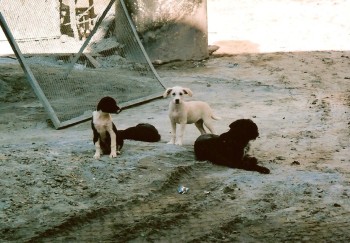 |
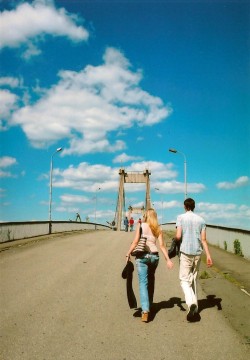 |
||
 |
|||
|
Monday 9 /
Day Two
The Irish Rover Roaming around Podil, the picturesque historical Kiev neighbourhood. The noble elegance of churches mixes with the down-to-earth straightforwardness of graffiti, creating a charming cocktail. Writings on the walls never cease to disappoint – local sprayers give wise pieces of advice („Never work!“), express their steadfast opinions („Windows must die – Linux rules!“), vent their angst („Fucking mega city!“) and even offer parent-like warnings to their careless comrades („Play with narcotics and you’ll end up in a coffin!“). On our way back home in the evening, somebody gladdens us with a handful of leaflets. Useless rubbish? Nah, material for creative art. MacRua announces a ship-building operation, and before our train arrives, the first craft is finished and ready to sail. We name her the Irish Rover. Before we get out of the metro, she has three sister ships. A fleet of four interchangeable Irish Rovers doomed by their name to meet a sorrowful end in the waves. When you name a ship like that, you simply have to fulfill her destiny. So when we get home, MacRua briskly supplies a bowl and fills it with water. A bit of sitting in the kitchen and melancholically staring at the pocket sea, and the sailing vessel obediently gets soaked with water and starts to tilt. But wait, the Irish Rover needs a crew. MacRua finds some bits of paraffin wax – a suitable material for sturdy sailors. We get down to work, and I soon equip the half-sunken vessel with the first (or last) crew member. The guy looks sad and lonely, in urgent need of a companion, even if it should be only the captain’s old dog. But MacRua still isn’t satisfied with the results of his creativity. Since forming legs seems to pose a problem, I suggest creating a mermaid instead. A bit more of toiling, countless reworkings, and finally an elegant, busty, long-haired creature (about two times bigger than the hapless sailor) jumps into the water only to crawl aboard the sinking ship immediately and gladden the adventurer with her charming presence. Now the ocean’s waves can roll and the stormy winds can blow and the Irish Rover can turn nine times around and meet its inevitable fate. |
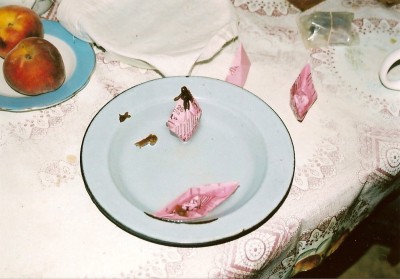 |
||
 |
||
| Tuesday 10 /
Day Three Chernihiv
A trip to Chernihiv aka Chernigov. An old town some 130 kilometres north of Kiev, whose panorama adorns each bottle of a popular brand of local beer. After exploring some fabulous churches (including the one from the beer bottle), we take a walk in a shady park overlooking the city. The edge of the park is lined with sinister cannons, long asleep, but still looking as if they were poised to shoot. At an approaching enemy? Nah, their barrels are unmistakably pointing at the gilded domes of the churches glinting in the summer sun. A bit deeper in the bowels of the park, a huge metal statue of Taras Shevchenko reclines on an equally oversized bench. It’s almost impossible to take a walk anywhere in Ukraine without bumping into a monument dedicated to the poet, the icon of Ukrainian culture. His statue – or rather statues, in plural – adorn every town and every city, his face stares at you from banknotes, his name was given to one of the stops of the Kiev metro. No way to escape, Shevchenko wherever you look. I finally come to the conclusion that every statue in fact shows the great poet, only in various disguises. Shevchenko as an army general, Shevchenko as Pushkin, Shevchenko as a cossack leader. Do you think this is a statue of Lenin? Wrong. It’s Shevchenko as a marxist revolutionary. On our way to more places of interest, we walk through a quiet part of the town. In fact, it doesn’t look like a town at all. Wooden houses huddled under overgrown trees give the impression of a village in the heart of a city. We walk down a calm alley passing between village-like houses on one side and blocks of flats on the other. Late afternoon stillness, flowerbeds full of blooms, a bunch of small boys kicking a ball in the middle of the road. MacRua suddenly tries to draw my attention somewhere among the plants. I look down, but fail to see anything unusual. A flowerbed in front of a house, so what? A bit overgrown and unkempt. What the...? I raise my eyes and finally spot it. I should have looked up, not down. A giant cannabis plant towers in the midst of the greenery. And it’s not alone. On both sides of the road, more plants of the same kind happily flourish. Among them, the kids merrily play, laughing and extracting the stray ball from under their characteristic leaves. What a joyful symbiosis... We progress to another church, this one famous for its underground manmade caves, which once served as a place of prayer and burial. Before entering, visitors can study a rough scheme of the underground maze of corridors and chambers, sketched on a wall. From then on, they are left to their own devices. There are electric lights in the caves, and information signs provide details about the construction of the place and about purposes of the individual chambers, including an in-depth description of the process of handling the bones of the deceased in the ossuary. But any plans or arrows showing the way? Nah, this is a place for adventurers. What could be more exciting than getting lost in dimly lit underground corridors among old graves? After roaming the eerie maze for a while, I finally spot one lonely arrow on the wall, which claims to show the direction of the tour. I obediently follow it down a narrow corridor, then up a flight of stairs, to a heavy door made of dark wood. I press the handle – nothing. The door is firmly locked. A fair revenge for cowardly obeying signs and refusing to play the adventure game along... Anyway, it is possible to find the way out of the labyrinth and to explore the nearby belltower – and to wonder how come that so many people eager to immortalize their names on the black metal railings of the tower were suitably equipped with special white paint allowing them to fulfil their desire. Maybe the paint is sold down in the souvenir shop? If not, it would be a brilliant business idea. |
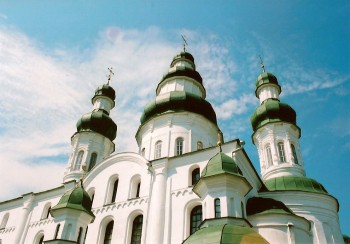 |
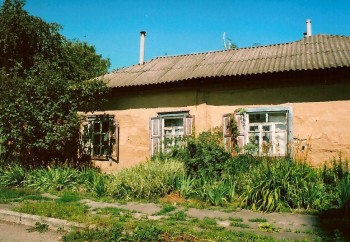 |
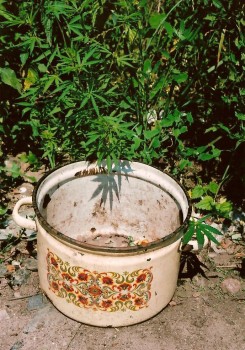 |
|
 |
|
| Part 1 Part 2 Part 3 Part 4 Part 5 |
text and photos © Zuzana, 2007 |
 |